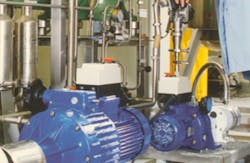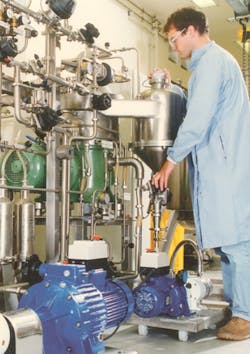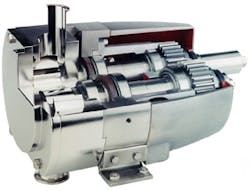A world-renowned eye care leader required a reliable and sanitary pump it could use to keep its pharmaceutical grade saline solution flowing throughout production. The manufacturing process incorporates an inline bottle-filling machine that uses a pump to keep it optimally filled.
This pump not only had to keep the production line moving with little or no downtime, but it also had to be able to meet the U.S. Food and Drug Administration’s (FDA) sanitary requirements throughout the process.
After some initial research, the plant’s engineers determined the pump head needed to be made of a high-grade 316L stainless steel, the grade best suited for the company’s pharmaceutical manufacturing process. The production line involved continuous exposure to saline solution—a corrosive mix that includes salt—at the pump head, and this grade of steel can resist the damaging effects of saline. Use of this top-grade steel requires less maintenance so the saline solution could keep flowing into the bottles without constant interruption for repairs.
Another issue to be considered was that the company’s filling machine could only accommodate horizontal porting for hose connections. The pump selected would have to match the existing hose connection or porting arrangement. But horizontal porting prevents fluid from completely draining from the pump, which is problematic when cleaning it. Pumps are usually installed with vertical porting so that when being cleaned in place the pump empties from the bottom. This mitigates having to halt production to remove the pump from the line in order to clean it.
In this case, a new drain port would have to be added to the pump’s end cover to meet the requirement for horizontal porting and to allow the pump head to be fully drained during cleaning. This requirement became a custom design feature that allowed the pump to be cleaned and drained in place. With this new customized drain port, the drain screw can now be removed to allow the cleaning agent to drain from the pump head after each cleaning process.
Due to the abrasive nature of saline, the pump also required a fluid flush in order to maintain the lubricated seal faces, and to prevent crystalizing of the salt on the seal face or even seal failure. A robust seal was an absolute necessity.
Saline can also be adversely impacted by a pumping action that’s too fast or creates friction heat. A pump where the pumping rate could be customized but still treat the product gently; and not cause it to be broken down from heat or the action of the pump itself, was the final requirement.
Hygienic Solution: Rotary Lobe Pump
The solution that ticked all the boxes? A hygienic rotary positive-displacement pump proved to be the best candidate for the job. In general, rotary lobe pumps are designed for industrial, food and biopharmaceutical applications. These types of pumps are differentiated by the design of the pump head, which can accommodate the pumping of harsh chemicals or strictly controlled hygienic products.
Rotary lobe pumps are designed so the fluid, or product, fills the expanding inlet cavity and then is displaced by a decreasing cavity on the outlet side. This action moves the content. Next, two counter-rotating rotors provide a gentle movement with minimal fluid or product damage from the pumping action. The rotors are typically driven by an electric motor (although it’s not uncommon to have them driven by a hydraulic motor). The speed and power of the drive motor can be adjusted to the flowrate desired for the manufacturing process.
Aside from the rotary lobe pump’s ability to provide a gentle pumping action, it’s also designed to handle product with the viscosity of up to 1 million centipoise. (Centipoise is a unit measure of viscosity). For example, water has a constant viscosity centipoise of one. In contrast, mayonnaise or tomato sauce has a viscosity of 20,000 centipoise, and is referred to as a shear-thinning product.
The term shear refers to the fact that when a force, such as pumping action is applied, a product goes from being thick like honey to a more liquid form. As the product is pumped, it begins to shear, or flow easily.
There’s also a choice in terms of how the rotors inside the pump interact. The pumps can be manufactured to have contacting rotors or non-contacting, so the rotors never touch. There are advantages as well disadvantages to both designs.
With a contacting rotor, one advantage is the ability for the pump head to prime, meaning draw fluid into the pump head by creating suction or inlet pressure. But, when two metal components like the rotor and the pump head itself come in contact, this creates excessive wearing of metal components. In addition, the materials that are worn away can enter the fluid or product during manufacturing. This can be dangerous. Aside from the wearing metal entering into the fluid to potentially taint the product, from a service perspective it creates higher maintenance from worn out rotors that would require regular replacement. In addition, as the rotors become worn, the ability to prime becomes less and less.
In a non-contacting rotor design, the rotors have an extremely tight tolerance between them and the pump head. Although these tight tolerances won’t allow the pump to self-prime, they do provide some superior hygienic design advantages. First, since the rotors are non-contacting there’s no loss of material and none enters the fluid or product. Since the rotors aren’t creating wear, service isn’t required. Non-contacting rotors should never have to be replaced, since rotor wear is not a factor. The non-contacting rotor design ensures that no contaminants could enter the saline solution during the filling phase of production. To the company’s engineers, this type of pump was the best option based on the requirements of the extremely hygienic manufacturing process.
Seal Orientation
Another successful design element involves the placement of seals inside the pump. Rotary lobe pumps, as with most pumps, require a seal to close off any leak paths where fluid or product could escape from the wet end of the pump head. On rotary lobe pumps, seals are installed in between the rotors and the shafts, in or behind the wet end of the pump head. The location of the seals is referred to as rear or front-loaded seal orientation.
On a rear-loaded seal, the shaft seals are located on the backside of the pump head. The drawback of a rear-loaded seal is that when it requires replacement due to maintenance or failure, the pump head has to be removed completely. This creates system downtime, not an ideal situation. The pump head would have to be disassembled to replace the seals, then reassembled, and then the rotors would need to be resynchronized to ensure proper rotor alignment and timing.
With a front-loaded seal design, however, the seals are located immediately under the rotors in the wet end of the pump head. These two seals are quickly accessible by simply removing the pump end cover, and then removing the two rotors off the shafts to expose the seals. The seals can be removed and serviced or exchanged without removing the pump from the system or disassembling the pump head. Since the wet end of the pump isn’t being removed from the rest of the pump, the rotors don’t have to be resynchronized, ensuring a quick and efficient replacement of seals.
When weighing all of the advantages and disadvantages of the pumps available, the engineers from the global eye care solution maker selected the Ultima Rotary Lobe pump model LU520-1790EZ from Jabsco, a Xylem brand, which fulfilled all of their requirements. The pump is made with 316L stainless steel rotor casing and rotors, which allows the customer to pump saline without corroding the pump head. In addition to the custom drain, its primary silicone-carbide on silicone-carbide seals reduce maintenance and provide the best internal sealing option.
www.xyleminc.com
David Caldwell, Product Manager for Xylem Inc.’s Applied Water Systems Business, is responsible for hygienic positive-displacement processing pumps and tubular membrane technologies utilized in biopharmaceutical, pharmaceutical, and food & beverage manufacturing. Mr. Caldwell can be reached at [email protected].




